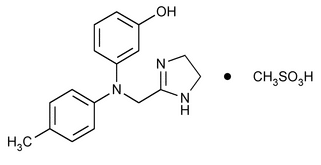Phentolamine Mesylate
(fen tol' a meen mes' i late).
Phenol, 3-[[(4,5-dihydro-1H-imidazol-2-yl)methyl](4-methyl-phenyl)amino]-, monomethanesulfonate (salt).
m-[N-(2-Imidazolin-2-ylmethyl)-p-toluidino]phenol monomethanesulfonate (salt)
» Phentolamine Mesylate contains not less than 98.0 percent and not more than 102.0 percent of C17H19N3O·CH4O3S, calculated on the dried basis.
Packaging and storage—
Preserve in tight, light-resistant containers. Store at 25 , excursions permitted between 15
, excursions permitted between 15 and 30
and 30 .
.
Identification—
C:
The RF value of the principal spot in the chromatogram of the Identification preparation corresponds to that of Standard preparation A as obtained in the test for Chromatographic purity.
Loss on drying  731
731 —
Dry it in vacuum at 60
—
Dry it in vacuum at 60 for 4 hours: it loses not more than 0.5% of its weight.
for 4 hours: it loses not more than 0.5% of its weight.
Residue on ignition  281
281 :
not more than 0.1%.
:
not more than 0.1%.
Sulfate  221
221 —
A 0.10-g portion shows no more sulfate than corresponds to 0.20 mL of 0.020 N sulfuric acid (0.2%).
—
A 0.10-g portion shows no more sulfate than corresponds to 0.20 mL of 0.020 N sulfuric acid (0.2%).
Chromatographic purity—
Standard preparations—
Dissolve USP Phentolamine Mesylate RS in methanol, and mix to obtain Standard preparation A having a known concentration of 50 µg per mL. Quantitatively dilute with methanol to obtain Standard preparations, designated below by letter, having the following compositions:
| Standard preparation |
Dilution | Concentration (µg RS per mL) |
Percentage (%, for comparison with test specimen) |
|---|---|---|---|
| A | (undiluted) | 50 | 0.5 |
| B | (3 in 5) | 30 | 0.3 |
| C | (1 in 5) | 10 | 0.1 |
Test preparation—
Dissolve an accurately weighed quantity of Phentolamine Mesylate in methanol to obtain a solution containing 10 mg per mL.
Identification preparation—
Dilute a portion of the Test preparation quantitatively with methanol to obtain a solution containing 50 µg per mL.
Detection reagent—
Prepare (1) a solution of 1 g of potassium ferricyanide in 20 mL of water, and (2) a solution of 1.9 g of ferric chloride in 20 mL of water. Just prior to use, mix equal volumes of the solutions.
Procedure—
Apply separately 5 µL of the Test preparation, 5 µL of the Identification preparation, and 5 µL of each Standard preparation to a suitable thin-layer chromatographic plate (see Chromatography  621
621 ) coated with a 0.25-mm layer of chromatographic silica gel, and allow to dry. Position the plate in a chromatographic chamber, and develop the chromatograms in a solvent system consisting of a mixture of chloroform, diethylamine, and methanol (15:3:2) until the solvent front has moved about three-fourths of the length of the plate. Remove the plate from the developing chamber, mark the solvent front, and dry the plate at 100
) coated with a 0.25-mm layer of chromatographic silica gel, and allow to dry. Position the plate in a chromatographic chamber, and develop the chromatograms in a solvent system consisting of a mixture of chloroform, diethylamine, and methanol (15:3:2) until the solvent front has moved about three-fourths of the length of the plate. Remove the plate from the developing chamber, mark the solvent front, and dry the plate at 100 for 1 hour. Spray the plate with Detection reagent. Within 15 minutes after spraying, compare the intensities of any secondary spots observed in the chromatogram of the Test preparation with those of the principal spots in the chromatograms of the Standard preparations: no secondary spot from the chromatogram of the Test preparation is larger or more intense than the principal spot obtained from Standard preparation A (0.5%), and the sum of the intensities of all secondary spots obtained from the Test preparation corresponds to not more than 1.0%.
for 1 hour. Spray the plate with Detection reagent. Within 15 minutes after spraying, compare the intensities of any secondary spots observed in the chromatogram of the Test preparation with those of the principal spots in the chromatograms of the Standard preparations: no secondary spot from the chromatogram of the Test preparation is larger or more intense than the principal spot obtained from Standard preparation A (0.5%), and the sum of the intensities of all secondary spots obtained from the Test preparation corresponds to not more than 1.0%.
Assay—
0.1 N Tetrabutylammonium hydroxide in isopropyl alcohol—
Dilute with dehydrated isopropyl alcohol a commercially available 25% solution of tetrabutylammonium hydroxide in methanol, and standardize as directed under Tetrabutylammonium Hydroxide, Tenth-Normal (0.1 N) (see Volumetric Solutions in the section Reagents, Indicators, and Solutions), using dehydrated isopropyl alcohol instead of dimethylformamide.
Procedure—
Dissolve with the aid of sonication, if necessary, about 300 mg of Phentolamine Mesylate, accurately weighed, in 100 mL of dehydrated isopropyl alcohol. Titrate in an atmosphere of nitrogen with 0.1 N Tetrabutylammonium hydroxide in isopropyl alcohol, determining the endpoint potentiometrically, using a glass electrode and a calomel electrode containing a saturated solution of tetramethylammonium chloride in dehydrated isopropyl alcohol (see Titrimetry  541
541 ). Perform a blank determination, and make any necessary correction. Each mL of 0.1 N tetrabutylammonium hydroxide is equivalent to 37.75 mg of C17H19N3O·CH4O3S.
). Perform a blank determination, and make any necessary correction. Each mL of 0.1 N tetrabutylammonium hydroxide is equivalent to 37.75 mg of C17H19N3O·CH4O3S.
Auxiliary Information—
Please check for your question in the FAQs before contacting USP.
| Topic/Question | Contact | Expert Committee |
|---|---|---|
| Monograph | Sujatha Ramakrishna, Ph.D.
Senior Scientific Liaison 1-301-816-8349 |
(SM22010) Monographs - Small Molecules 2 |
| Reference Standards | RS Technical Services 1-301-816-8129 rstech@usp.org |
USP35–NF30 Page 4294
Pharmacopeial Forum: Volume No. 29(5) Page 1562

